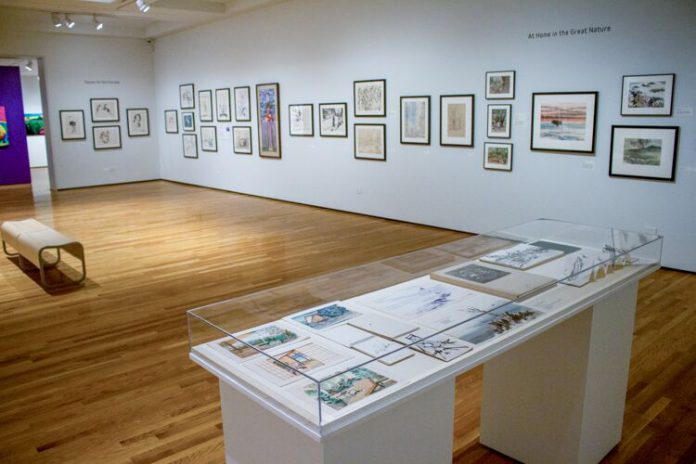Jessica Gang
Staff Writer
This April, the “Chiura Obata: An American Modern” exhibit is wrapping up a four-month run at the Art, Design, and Architecture Museum here at UCSB. The exhibit, which includes work from every decade of Obata’s career, gives the audience a unique look into how personal events in Obata’s life influenced the themes and artistic techniques of his work.
“An American Modern” came to UCSB as part of the collaborative efforts of curator and UCSB alumnus ShiPu Wang and the curating team at the Art, Design, and Architecture Museum. In an interview with The Bottom Line, Wang, an associate professor at UC Merced, said that he chose to curate an exhibit about Obata because he “hoped that audiences will have the chance to rediscover artists like Obata” who were never considered quintessentially American but whose works nevertheless celebrated the beauty of America.
“Chiura Obata: An American Modern” follows Obata’s artistic origins, beginning with his elite art training in Japan during the 1890s and tracing his development into an illustrator and fully formed artist. Obata’s artistic development coincided with changes in his personal life, which are also represented in the exhibit.
One of the most striking aspects of the exhibit is the sheer amount of stylistic diversity it contains. The viewer begins by walking through an early collection of traditionally painted Japanese pieces that Obata completed in the sumi-e style as a young apprentice in Tokyo.
Location largely influences Obata’s work; he immigrated from Japan to San Francisco in 1903 and began to experiment with a diverse array of Western painting techniques, which can be seen through the many sketches and paintings of Yosemite National Park present. The exhibit also contains sketches and photos of Obata’s classroom during his tenure as a professor at UC Berkeley. At the onset of World War II, Obata and his family, along with thousands of other Japanese immigrants, were relocated to the Topaz Internment Camp as part of the Japanese American Internment (1942-1945).
Obata’s style, which had previously consisted of beautiful watercolors and broad, sweeping landscapes, devolved into rough, hurried black and white sketches of daily life at Topaz that encapsulated the discouragement and disillusionment that many Japanese-Americans faced during the internment period.
Obata’s works after his release from internment were more contemplative than his previous pieces — a much older Obata finally returned to painting landscapes of Japan, a subject that had largely faded from his work. In particular, Obata’s landscapes of the restoration of Japan in the aftermath of the attack on Hiroshima are imbued with a tentative hope, and the desire to rebuild. Sentimental themes pervade Obata’s final pieces, which are simple, serene depictions of his California home and the surrounding nature.
Throughout Obata’s rich and varied artistic career, the only constants seem to be his appreciation of the power of nature (“Great Nature,” as he called it) and his belief in the unique ability of art to capture the strength of the human spirit.
According to Wang, there are two things that he hopes viewers can take from the exhibit: the first urges readers to “think about what it means to be American, in visual and artistic terms.” The definition of American art is constantly changing, and how and why are are certain artists included and excluded?
Secondly, Wang hopes that viewers consider how “what [Obata] went through has relevance in our time, and the battles we are going through.” Specifically, it’s important to consider how Obata’s peaceful protest through art can be a lesson to us in these tumultuous political times.
The exhibit will end its run at the Art, Design, and Architecture Museum through Apr. 29, traveling next to the Utah Museum of Fine Arts in Salt Lake City before making additional stops in Obata’s birthplace of Okayama, Japan and Sacramento, California before concluding at the Smithsonian American Art Museum in Washington, D.C., from Nov. 2019 through April 2020.
In addition to curating the exhibit, Wang designed the DigitalObata app (available in the iTunes store) an “augmented viewing” experience meant to increase viewer engagement with the pieces contained in the exhibit. “Chiura Obata: An American Modern,” a book published by University of California Press, is also available for purchase at the AD&A Museum and contains photos of Obata’s work as well as selected writings of Obata and scholarly writings by other contributors.
An earlier version of this article stated the “Chiura Obata: An American Modern” exhibit would conclude in Sacramento, California. It will conclude at the Smithsonian American Art Museum in Washington, D.C.

















